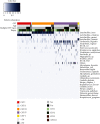Age-Stratified Analysis of Vaginal Microbiota Dysbiosis and the Relationship with HPV Viral Load in HPV-Positive Women
- PMID: 35935589
- PMCID: PMC9348945
- DOI: 10.1155/2022/1372926
Age-Stratified Analysis of Vaginal Microbiota Dysbiosis and the Relationship with HPV Viral Load in HPV-Positive Women
Abstract
Objective: This study evaluated the distribution of vaginal microbiota dysbiosis and the association with HPV viral load test in high-risk HPV-positive women before and after 50 years old.
Methods: For this cross-sectional study, 388 HPV-positive women prior to referral to colposcopy in Peking University Peoples' Hospital were included and classified as younger than 50 years (n = 307) and aged 50 years or older (n = 81), midvagina bacterial community composition was characterized by FlashDetect™ MAX vaginal microbe detection kit, and BMRT-HPV reported type-specific viral loads/10,000 cells.
Results: The community state type (CST) IV was the most common CST occurring in 148 women (38.1%). The proportion of CST IV in those aged 50 years or older was significantly higher than those younger than 50 years (women) (66.7% vs. 30.6%); the difference was statistically significant (<0.001). CST distribution has no statistical difference in different grades of cervical lesion, regardless of the age (p = 0.238 and 0.263). However, the women with high-grade cervical lesion presented a more complicated trend and the abundance of vaginal microbiota dysbiosis than low-grade lesion. HPV16/18 viral load was found to be significantly higher in CST III and CST IV than CST I/II/V (p < 0.05)in women younger than 50 years.
Conclusions: In women younger than 50 years, higher HPV16/18 load was more closely associated with CST IV; however, it had no significant correlation in women aged 50 years or older.
Copyright © 2022 Mingzhu Li et al.
Conflict of interest statement
The authors have no relevant financial or nonfinancial interests to disclose.
Figures



Similar articles
-
The vaginal metabolome and microbiota of cervical HPV-positive and HPV-negative women: a cross-sectional analysis.BJOG. 2020 Jan;127(2):182-192. doi: 10.1111/1471-0528.15981. Epub 2019 Nov 20. BJOG. 2020. PMID: 31749298 Free PMC article.
-
Vaginal Microbiota Changes Caused by HPV Infection in Chinese Women.Front Cell Infect Microbiol. 2022 Jun 21;12:814668. doi: 10.3389/fcimb.2022.814668. eCollection 2022. Front Cell Infect Microbiol. 2022. PMID: 35800384 Free PMC article.
-
[Distribution of serum antibodies against human papillomavirus 16 and 18 among high-risk women to cervical cancer].Zhonghua Liu Xing Bing Xue Za Zhi. 2014 May;35(5):514-8. Zhonghua Liu Xing Bing Xue Za Zhi. 2014. PMID: 25059358 Chinese.
-
Determination of HPV type 16 and 18 viral load in cervical smears of women referred to colposcopy.J Med Virol. 2006 Aug;78(8):1131-40. doi: 10.1002/jmv.20673. J Med Virol. 2006. PMID: 16789021
-
Vaginal dysbiosis and the risk of human papillomavirus and cervical cancer: systematic review and meta-analysis.Am J Obstet Gynecol. 2019 Jul;221(1):9-18.e8. doi: 10.1016/j.ajog.2018.12.011. Epub 2018 Dec 12. Am J Obstet Gynecol. 2019. PMID: 30550767
Cited by
-
Vaginal microbiota changes of persistent human papillomavirus infection after cervical conization.Front Cell Infect Microbiol. 2025 Apr 14;15:1544794. doi: 10.3389/fcimb.2025.1544794. eCollection 2025. Front Cell Infect Microbiol. 2025. PMID: 40297613 Free PMC article.
-
Characterization of vaginal Lactobacillus species as a predictor of fertility among Iranian women with unexplained recurrent miscarriage and fertile women without miscarriage history using machine learning modeling.Mol Biol Rep. 2023 Nov;50(11):8785-8797. doi: 10.1007/s11033-023-08745-2. Epub 2023 Aug 29. Mol Biol Rep. 2023. PMID: 37644372
-
PAX1/JAM3 Methylation and HPV Viral Load in Women with Persistent HPV Infection.Cancers (Basel). 2024 Apr 7;16(7):1430. doi: 10.3390/cancers16071430. Cancers (Basel). 2024. PMID: 38611108 Free PMC article.
-
Distinct cervical microbiome and metabolite profiles before and after menopause: implications for cervical cancer progression.Front Cell Infect Microbiol. 2025 Jul 16;15:1589277. doi: 10.3389/fcimb.2025.1589277. eCollection 2025. Front Cell Infect Microbiol. 2025. PMID: 40740347 Free PMC article.
-
Cervicovaginal-Microbiome Analysis by 16S Sequencing and Real-Time PCR in Patients from Novosibirsk (Russia) with Cervical Lesions and Several Years after Cancer Treatment.Diagnostics (Basel). 2023 Jan 1;13(1):140. doi: 10.3390/diagnostics13010140. Diagnostics (Basel). 2023. PMID: 36611432 Free PMC article.
References
-
- Andersson S., Safari H., Mints M., Lewensohn-Fuchs I., Gyllensten U., Johansson B. Type distribution, viral load and integration status of high-risk human papillomaviruses in pre-stages of cervical cancer (CIN) British Journal of Cancer . 2005;92(12):2195–2200. doi: 10.1038/sj.bjc.6602648. - DOI - PMC - PubMed
-
- Dalstein V., Riethmuller D., Pretet J. L., Le Bail C. K., Sautiere J. L. Persistence and load of high-risk HPV are predictors for development of high-grade cervical lesions: a longitudinal French cohort study. International Journal of Cancer . 2003;106(3):396–403. doi: 10.1002/ijc.11222. - DOI - PubMed
MeSH terms
LinkOut - more resources
Full Text Sources

